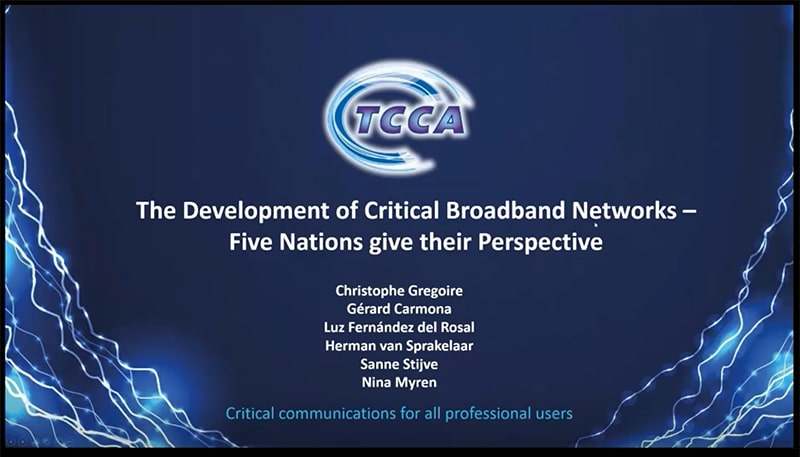
Participants included: Christophe Gregoire, Director, Technology & Operations at ASTRID (Belgium); Gérard Carmona, in charge of the national and international relationships with the future radio network program directorate, Ministère De L’Intérieur (France); Luz Fernández del Rosal, International Cooperation Directorate Strategy and Central Management Federal Agency for Public Safety Digital Radio (Germany); Herman van Sprakelaar, program manager, the Police of the Netherlands; and Sanne Stijve, Program Director for Secure Mobile Broadband Communications at the Swiss Federal Office for Civil Protection. All of them shared their experience in a very interesting session in which it was possible to learn what stage the different countries are at in the implementation of their broadband systems.
First of all, and as it happened in the past, the continuity and validity of the TETRA networks was guaranteed at least until 2030. Representatives of the Belgian ASTRID network, as well as the German and Dutch systems, expressed their intention to extend the useful life of their systems at least until then, and to continue investing in them, as the Netherlands has just done with a complete renovation of its infrastructure.
France has a TETRAPOL network, a technology whose obsolescence is closer, and given that the country will host major sporting events in the coming years (Rugby World Cup in 2023 and the Paris Olympics in 2024), has already published the tender for the migration of its national network and it is expected that by 2025 it will have already been replaced. Switzerland, which also uses TETRAPOL technology, is however planning to extend the life of its current network until 2030.
Another aspect on which the speakers agreed was the way in which these networks should be developed, opting for a hybrid operating model. France, for the reason already mentioned, is the country that has made most progress in this migration process, and the tender was published in December last year under a Full MNVO (Mobile Network Virtual Operator) model. According to Gérard Carmona, their approach is based on strict compliance with the 3GPP interoperability framework for MCX, and their model includes a dedicated control node, their own MCX service and the radio access network of at least two mobile operators.
Christophe Gregoire explained that in Belgium, trials began years ago for a hybrid approach to broadband with a Mobile Network Virtual Operator (MNVO), which has been in operation since 2020 and is likely to coexist with the TETRA network for a long time. Gregoire believes that the hybrid scenario is vital to ensure continuity of service, and is committed to this model in 700MHz assuming that the public network operator ASTRID owns the Core Network, while the radio access network will be provided by several mobile operators.
In the Netherlands, the migration process is based on a 13 criteria (technical, economic, legal, etc.) analysis that considers the different deployment models. As Herman van Sprakelaar explained, among all of them, the dedicated network was discarded, whereas they analyse the possibility of choosing a “Fully outsourced” or “partially outsourced” model where the core and MCX services are deployed at the public level and the Radio Access Network belongs to the mobile operators. The NOOVA program is currently defining the deployment architecture, network requirements, making the necessary regulatory adjustments, etc.
In the case of Germany, and once it has been proven that the current operator networks cannot meet the needs of security agencies, the Broadband Taskforce program has already been launched to develop tests on hybrid networks with 3 scenarios: dedicated private network, commercial network and a hybrid model with shared Radio Access Network. Once the tests have been completed, the results will be presented to the Conference of Ministers of the Interior, and the final decision will be taken on the deployment and operating model, regulatory aspects, etc.
In Switzerland, work is already underway on the development of a broadband network that has been dubbed “MSK”. With regard to the regulatory framework, the central European country has already reserved spectrum in B28/B68 in accordance with the European recommendation, and the responsibilities for the new network have been defined: the State will be responsible for core management and network operation, while the cantons will be responsible for the sites. It is expected that an RFI will be launched to mobile operators on an operating model this year and that the bidding process will start in 2024.
Finally, some of the speakers also stressed the need to make regulatory adjustments so that the use of the radio services offered by mobile operators to public security and emergency entities is provided with certain guarantees of quality of service and availability.

